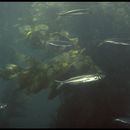en
names in breadcrumbs


Perception Channels: tactile ; chemical
Other Physical Features: bilateral symmetry
Clupeiformes /ˈkluːpiːɪfɔːrmiːz/ is the order of ray-finned fish that includes the herring family, Clupeidae, and the anchovy family, Engraulidae. The group includes many of the most important forage and food fish.
Clupeiformes are physostomes, which means that their gas bladder has a pneumatic duct connecting it to the gut. They typically lack a lateral line, but still have the eyes, fins and scales that are common to most fish, though not all fish have these attributes. They are generally silvery fish with streamlined, spindle-shaped, bodies, and they often school. Most species eat plankton which they filter from the water with their gill rakers.[1]
The former order of Isospondyli was subsumed mostly by Clupeiformes,[2] but some isospondylous fishes (isospondyls) were assigned to Osteoglossiformes, Salmoniformes, Cetomimiformes, etc.[3]
Dussumieriidae s.s.
ClupeidaeThe order includes about 405 species in eleven families:[5][6]

Clupeiformes /ˈkluːpiːɪfɔːrmiːz/ is the order of ray-finned fish that includes the herring family, Clupeidae, and the anchovy family, Engraulidae. The group includes many of the most important forage and food fish.
Clupeiformes are physostomes, which means that their gas bladder has a pneumatic duct connecting it to the gut. They typically lack a lateral line, but still have the eyes, fins and scales that are common to most fish, though not all fish have these attributes. They are generally silvery fish with streamlined, spindle-shaped, bodies, and they often school. Most species eat plankton which they filter from the water with their gill rakers.
The former order of Isospondyli was subsumed mostly by Clupeiformes, but some isospondylous fishes (isospondyls) were assigned to Osteoglossiformes, Salmoniformes, Cetomimiformes, etc.